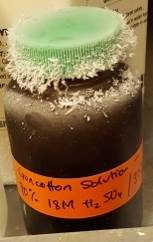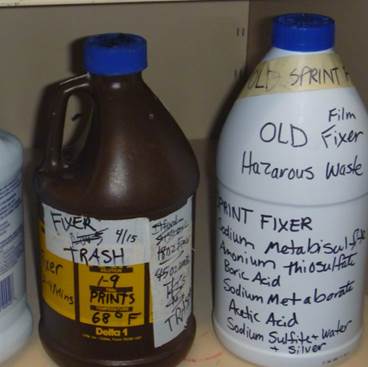
Site Owned by Upper Valley Lake Sunapee Regional Planning Commission
Safe Schools Project

Science Laboratories
School laboratories hold the potential for accidents. However, schools can greatly reduce the risks to students and educators. Writing a chemical hygiene plan is a great start. This will help schools identify who is responsible for ordering, storing, and disposing of chemicals. what chemicals the school does not want within the building as they are too dangerous, how to make chemistry classroom demonstrations and experiments safer, where to keep Safety Data Sheets, maintaining safety equipment, and keeping general order.
Integrated Pest Management (IPM) programs are designed to reduce health hazards to people that inhabit the building or structure. The least hazardous and least toxic pesticides are used when needed.
IPM does more than simply eliminate the pests you can see. IPM means looking at environmental factors that affect the pest and its ability to thrive. With this information, unfavorable conditions can be created to deter the pest.
The IPM principles and practices combine to create IPM programs. Five major components are common to all IPM programs: 1. Pest Identification; 2. Monitoring and assessing pest numbers and damage; 3. Guidelines for when management action is needed; 4. Preventing pest problems (e.g. keeping areas clean, sealing cracks); and 5. Using a combination of biological, cultural, physical/mechanical and chemical management tools.
We all understand that buildings must be cleaned, but there are different methods, equipment, and products that can be used to do the job. "Green cleaning" is cleaning to protect health without harming the environment. The focus of the Safe Schools project is on green cleaning. there is much research to confirm that green cleaning is effective, better for air quality and our health, and also cost effective.
Why should you care about how classrooms are cleaned at your school?
Some of these concerns stem from the very products used to keep the school clean. As a result, school children and staff are unnecessarily exposed to chemicals commonly found in traditional cleaning products, chemicals that have been linked to asthma and other respiratory problems, cancer, reproductive and neurological harm, and hormone disruption. Additionally, these products are known to have negative impacts on the environment, including contributing to water pollution, smog, and damage to the ozone layer.
Why this is a particular concern for those with asthma?
Asthma is a major problem for school-aged children and school employees. According to the New Hampshire State Health Improvement Plan 2013-2020, New Hampshire’s asthma rate is among the highest in the nation. Approximately 110,000 adults (2010) and 25,000 children in the state have asthma. Each year about 10% of adults and 8% of children are diagnosed with asthma, amounting to approximately 7,000 new cases.
Asthma is the leading cause of school absences due to chronic disease in the country, costing children their education and their schools resources in attendance-based funding. Work related asthma is high for school employees, including custodial workers who have one of the highest rates of occupational asthma in the country. Studies have linked the cleaning products used in schools to both the cause of asthma and the trigger of asthma attacks.
How are parents, students, and staff responding to this issue?
Schools are becoming increasingly aware that healthy and environmentally friendly facilities foster academic achievement and staff well-being. Proactive parents, students, and staff across the state have examined their school’s cleaning practices to develop strategies for improving student and staff health and reducing their impact on the environment. Developing healthy cleaning practices in schools is one strategy that has repeatedly proven successful across the country. Some schools have adopted the exclusive use of certified green cleaning products (e.g. Vermont). These products have been proven to effectively clean offices, schools, and other institutional facilities while meeting a number of health and environmental standards, including special consideration for exposures to children.
To read more about the experience of three school districts in California, see the Regional Asthma Management & Prevention report, Breathing Easier: School Districts Make the Switch to Certified Green Cleaning Products.
What are environmentally preferable, green cleaning products?
Conveying a clear solution is as important as outlining the problem. “Environmentally Preferable” and “Green Cleaning Products” are terms often used to describe the newly formulated cleaning products that are alternatives to conventional cleaning products. Recognizing that neither of these labels eliminates all health and environmental risks, switching to third party certified green cleaning products provides schools with a straight forward way of identifying and using the least toxic products available.
Third-party certifiers establish health and environmental standards for products though a transparent process that includes stakeholder involvement. Products must meet these published standards in order to receive the certified label. Three certifiers with standards for institutional cleaners used in schools are Green Seal, EcoLogo, and EPA’s Safer Choice. Each certification program is different, so it is important to familiarize yourself with the various standards if you are going to suggest that schools use them.
What can you do?
Change does not happen on its own. Committed parents, students, teachers, staff, and other advocates must choose to get involved with their schools and support them in making the switch. Follow the guidance in the Taking Action section to see how you can help reduce environmental asthma triggers and create a healthier school.
Source: Green Cleaning in Schools: A Guide for Advocates, Regional Asthma Management & Prevention.
SITE SEARCH